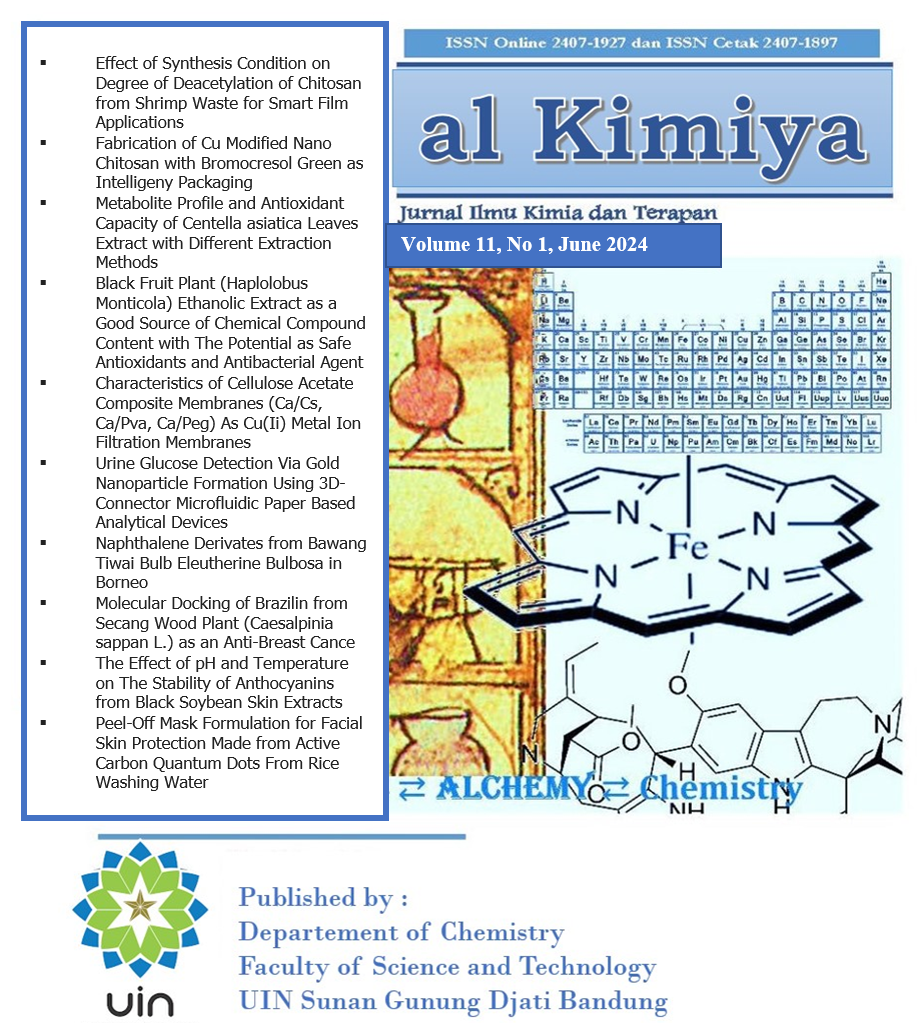The Effect of pH and Temperature on The Stability of Anthocyanins from Black Soybean Skin Extracts
DOI:
https://doi.org/10.15575/ak.v11i1.35861Keywords:
anthocyanins, black soybean skin, effect of pH and temperatureAbstract
References
H. Jang et al., “Anthocyanin extracted from black soybean reduces prostate weight and promotes apoptosis in the prostatic hyperplasia-induced rat modelâ€, J Agric Food Chem, 58(24), 12686–12691, 2010. https://doi.org/10.1021/jf102688g
S. Winarni, U. Sarofa, and D. Anggrhini, “Ekstraksi dan stabilitas warna ubi jalar ungu sebagai pewarna alamiâ€, Jurnal Teknik Kimia, 8(1), 1998.
B. A. Cevallos-Casals and L. Cisneros-Zevallos, “Stability of anthocyanin-based aqueous extracts of andean purple corn and red-fleshed sweet potato compared to synthetic and natural colorantsâ€, Food Chem, 86(1), 69–77, 2004. https://doi.org/10.1016/j.foodchem.2003.08.011
S. Wahyuningsih, L. Wulandari, M. W. Wartono, H. Munawaroh, and A. H. Ramelan, “The effect of pH and color stability of anthocyanin on food colorantâ€, in IOP Conference Series: Materials Science and Engineering, Institute of Physics Publishing, 2017. https://doi.org/10.1088/1757-899X/193/1/012047
G. Burgos et al., “Total phenolic, total anthocyanin and phenolic acid concentrations and antioxidant activity of purple-fleshed potatoes as affected by boilingâ€, Journal of Food Composition and Analysis, 30(1), 6–12, 2013. https://doi.org/10.1016/j.jfca.2012.12.001
S. Ariviani, “Total antosianin ekstrak buah salam dan korelasinya dengan kapasitas anti peroksidasi pada sistem linoelatâ€, Agrointek, 4(2), 121-127 2010. https://doi.org/10.21107/agrointek.v4i2.1364
J. Jenshi, M. Saravanakumar, K. M. Aravindhan, And P. Suganya, “The effect of light, temperature, pH on stability of anthocyanin pigments in Musa Acuminata Bractâ€, Res Plant Biol, 1(5), 5–12, 2011. [Online]. Available: Www.Resplantbiol.Com
F. Delgado-Vargas, A. R. Jiménez, O. Paredes-López, And F. J. Francis, “Natural pigments: carotenoids, anthocyanins, and betalains - characteristics, biosynthesis, processing, and stabilityâ€, Crit Rev Food Sci Nutr, 40(3), 173–289, 2000. https://doi.org/10.1080/10408690091189257
Y. W. Zhao, C. K. Wang, X. Y. Huang, And D. G. Hu, “Anthocyanin stability and degradation in plantsâ€, Plant Signaling And Behavior, 16(12), Taylor And Francis Ltd., 2021. https://doi.org/10.1080/15592324.2021.1987767
S. Oancea, “A reviewof the current knowledge of thermal stability of anthocyanins and approaches to their stabilization to heat. Antioxidantsâ€, Mdpi , 10,(9), 2021. https://doi.org/10.3390/antiox10091337
M. Kumar Samota Et Al., “Onion anthocyanins: extraction, stability, bioavailability, dietary effect, and health implicationsâ€, Frontiers in Nutrition, 2022. https://doi.org/10.3389/fnut.2022.917617
X. Sui, X. Dong, And W. Zhou, “Combined effect of pH and high temperature on the stability and antioxidant capacity of two anthocyanins in aqueous solutionâ€, Food Chem, 163–170, 2014. https://doi.org/10.1016/j.foodchem.2014.04.075
M. Priska, N. Peni, L. Carvallo, And Y. Dala Ngapa, “Review: antosianin dan pemanfaatannyaâ€, 2018.
B. Enaru, G. DreÈ›canu, T. D. Pop, A. StÇŽnilÇŽ, and Z. Diaconeasa, “Anthocyanins: factors affecting their stability and degradation. Antioxidantsâ€, MDPI, 10(12), 2021. https://doi.org/10.3390/antiox10121967
W. Nurtiana, “Anthocyanin as natural colorant: a reviewâ€, Food ScienTech Journal, 1(1), 1, 2019. https://doi.org/10.33512/fsj.v1i1.6180
N. Tena, J. MartÃn, and A. G. Asuero, “State of the art of anthocyanins: antioxidant activity, sources, bioavailability, and therapeutic effect in human health. Antioxidantsâ€, MDPI, 9(5), 2020. https://doi.org/10.3390/antiox9050451
L. Prietto et al., “pH-sensitive films containing anthocyanins extracted from black bean seed coat and red cabbageâ€, LWT, 80, 492–500, 2017. https://doi.org/10.1016/j.lwt.2017.03.006
P. Suganya Devi, M. Saravanakumar, and S. Mohandas, “The effects of temperature and pH on stability of anthocyanins from red sorghum (Sorghum bicolor) branâ€, African Journal of Food Science, 6(24), 567-573, 2012. http://dx.doi.org/10.5897/AJFS12.052
P. Loypimai, A. Moongngarm, and P. Chottanom, “Thermal and pH degradation kinetics of anthocyanins in natural food colorant prepared from black rice branâ€, J Food Sci Technol, 53(1), 461–470, 2016. https://doi.org/10.1007/s13197-015-2002-1
P.-Y. Chao et al., “Effects of black soybean on atherogenic prevention in hypercholesterolemic rabbits and on adhesion molecular expression in cultured HAECsâ€, Food Nutr Sci, 04(08), 9–21, 2013. https://doi.org/10.4236/fns.2013.48A002
D. Ryu and E. Koh, “Stability assessment of anthocyanins from black soybean, grape, and purple sweet potato under in vitro gastrointestinal digestionâ€, Food Sci Biotechnol, 31(8), 1053–1062, 2022. https://doi.org/10.1007/s10068-022-01071-6
Rianita Pramitasari, Felicia Roseline Sujonoputri, and Diana Elizabeth Waturangi, “Prebiotic activity of indonesian black soybean (Glycine max (L.) Merr) anthocyaninâ€, Magna Scientia Advanced Biology and Pharmacy, 2(2), 037–041, 2021. https://doi.org/10.30574/msabp.2021.2.2.0011
S. Mani and N. Chaturvedi, “Anthocyanin rich ready-to-serve beverage co-pigmented with black soybean extract and its effect on antioxidant profile and color stabilityâ€, 12(12), 3251–3256, 2023. [Online]. Available: www.thepharmajournal.com
L. Xu et al., “Anthocyanins from black soybean seed coat enhance wound healingâ€, Ann Plast Surg, 71(4), 415–420, 2013. https://doi.org/10.1097/SAP.0b013e31824ca62b
A. Mahmudatussa’adah, D. Fardiaz, N. Andarwulan, and F. Kusnandar, “Karakteristik warna dan aktivitas antioksidan antosianin ubi jalar ungu [color characteristics and antioxidant activity of anthocyanin extract from purple sweet potato]â€, Jurnal Teknologi dan Industri Pangan, 25(2), 176–184, 2014. https://doi.org/10.6066/jtip.2014.25.2.176
J. H. Lee et al., “Characterisation of anthocyanins in the black soybean (Glycine max L.) by HPLC-DAD-ESI/MS analysisâ€, Food Chem, 112(1), 226–231, 2009. https://doi.org/10.1016/j.foodchem.2008.05.056
Y. Liu, Y. Liu, C. Tao, M. Liu, Y. Pan, and Z. Lv, “Effect of temperature and pH on stability of anthocyanin obtained from blueberryâ€, Journal of Food Measurement and Characterization, 12(3), 1744–1753, 2018. https://doi.org/10.1007/s11694-018-9789-1
Downloads
Published
Issue
Section
Citation Check
License
Authors who publish with this journal agree to the following terms:
- Authors retain copyright and grant the journal right of first publication with the work simultaneously licensed under a Creative Commons Attribution 4.0 International License that allows others to share the work with an acknowledgment of the work's authorship and initial publication in this journal.
- Authors are able to enter into separate, additional contractual arrangements for the non-exclusive distribution of the journal's published version of the work (e.g., post it to an institutional repository or publish it in a book), with an acknowledgment of its initial publication in this journal.
- Authors are permitted and encouraged to post their work online (e.g., in institutional repositories or on their website) prior to and during the submission process, as it can lead to productive exchanges, as well as earlier and greater citation of published work (See The Effect of Open Access).

